We provide a wide variety of tours and activities for all interests and we ensure great experiences and safety.
Activities
Our Services
What We Offer

Hiking
Curu Wild Life Refuge is provided with various different trails so visitors can enjoy different ecosystems and a large number of animals. Among other things tourists can enjoy animals such as: the White-faced monkeys, Howler monkey, Cara Caras, White tail deer, aguti, cocodriles.
White-faced monkeys are easily observed around the administration area or on the trails, forming social groups of 25 individuals led by an Alpha male. Each troop patrols its territory in search of food based on insects and fruits. Spider monkeys are rare to see in the forest because they like the top of the trees, where they feel safe and have access to ripe fruits. The trails are easy and without risk of getting lost, however, if you hire a local guide, he will allow you to learn more about the history of Curu and understand the different ecosystems that interact in the area. Luis Schutt is a local guide, he is one of the owners and son of Federico Schutt, founder of Curu. With more than 10 years of experience guiding. Birds are definitely a major attraction within the Curu Wildlife Refuge, where resident birds can be observed all year round, but during the dry season this place is also visited by a large number of migratory birds, both terrestrial and aquatic. Depending on the month or time of your visit, you will find different varieties of species. Among the most common are the Motmot, Trogons, Long-tailed Manakin, Crested Caracara, Herons, Magpies and many more. Ghost crabs form a red carpet on the main beach in a large red spot, every time the tide goes out. In the interior, multi-colored crabs abound during the rainy season and sleep in their holes during the dry season. The “Tajalín” crab is very common in the coconut plantation area near the beach, within the mangroves the most common is the purple one. The most common reptiles within Curu are the “Garrobos” or gray iguana. The Basilisk or Jesus Christ, (for its ability to walk on water) are commonly located near the river. Boa Constrictors were used by Don Federico inside his residence because they are the best control for rats, better and cheaper than a cat. Trees are abundant and provide shelter and food for all species in the Refuge. Among the most notable are the majestic ceibos, which can reach more than forty meters in height. There are also native fruit trees that provide food and shelter for the species.
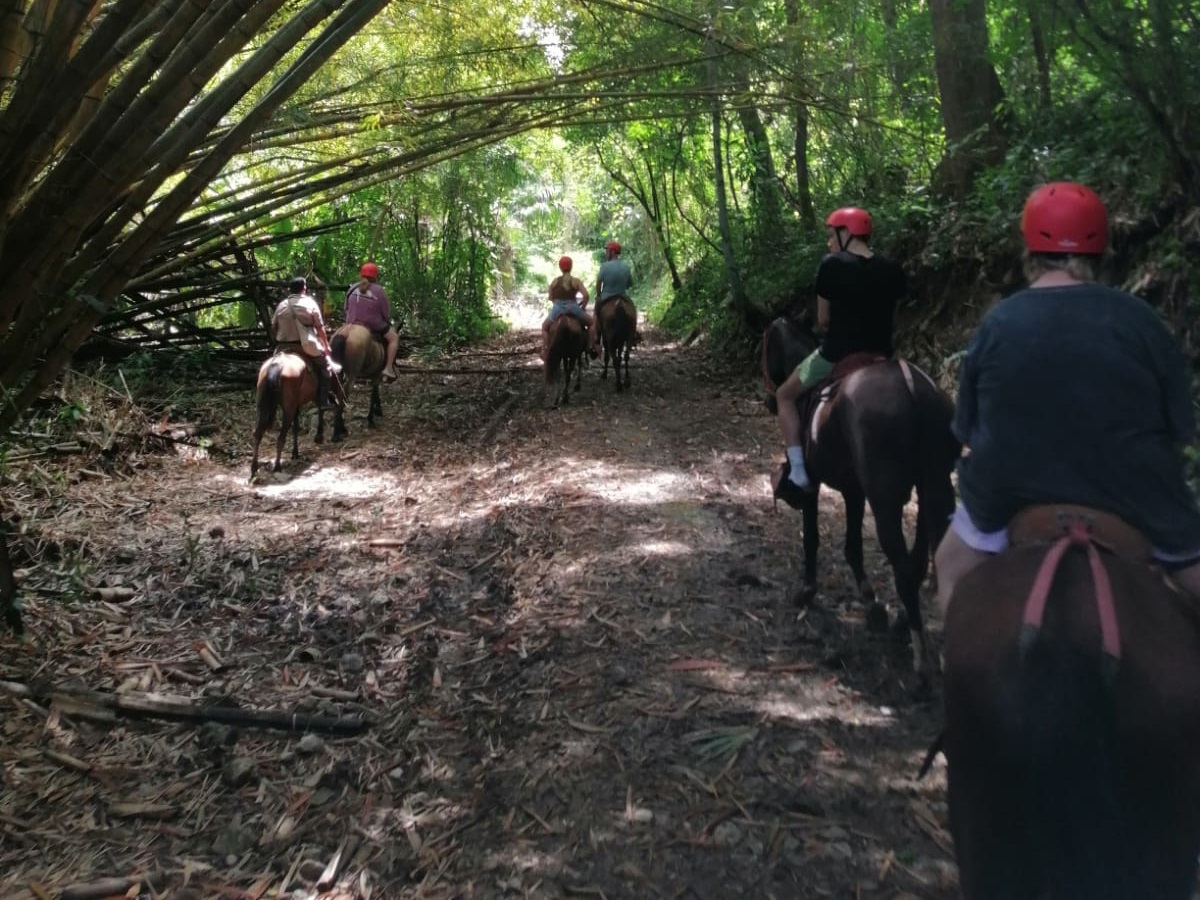
Horse tours
Enjoy a horseback ride on the horse trails inside Curu. You will see a variety of wildlife, such as monkeys, white tailed deer, wild pigs and other wild life or species that will not be seen on the walking trails. Visit the lookout point (vista point) to observe the beautiful beach of Curu.
Part of the tour will show you the grasslands where cattle are raised. Learn about the different ecosystems that interact in the flat areas of Curu. The trees in the places hold secrets that will be described on the tour. The horseback riding areas are flat and easily accessible and trained horses are used for tourists of all experience levels. Within this package you can combine a ride through the plains of Curu and then a boat ride to the Tortuga Islands. There you can go snorkelling or simply enjoy the coastal scenery and the beauty of the islands.
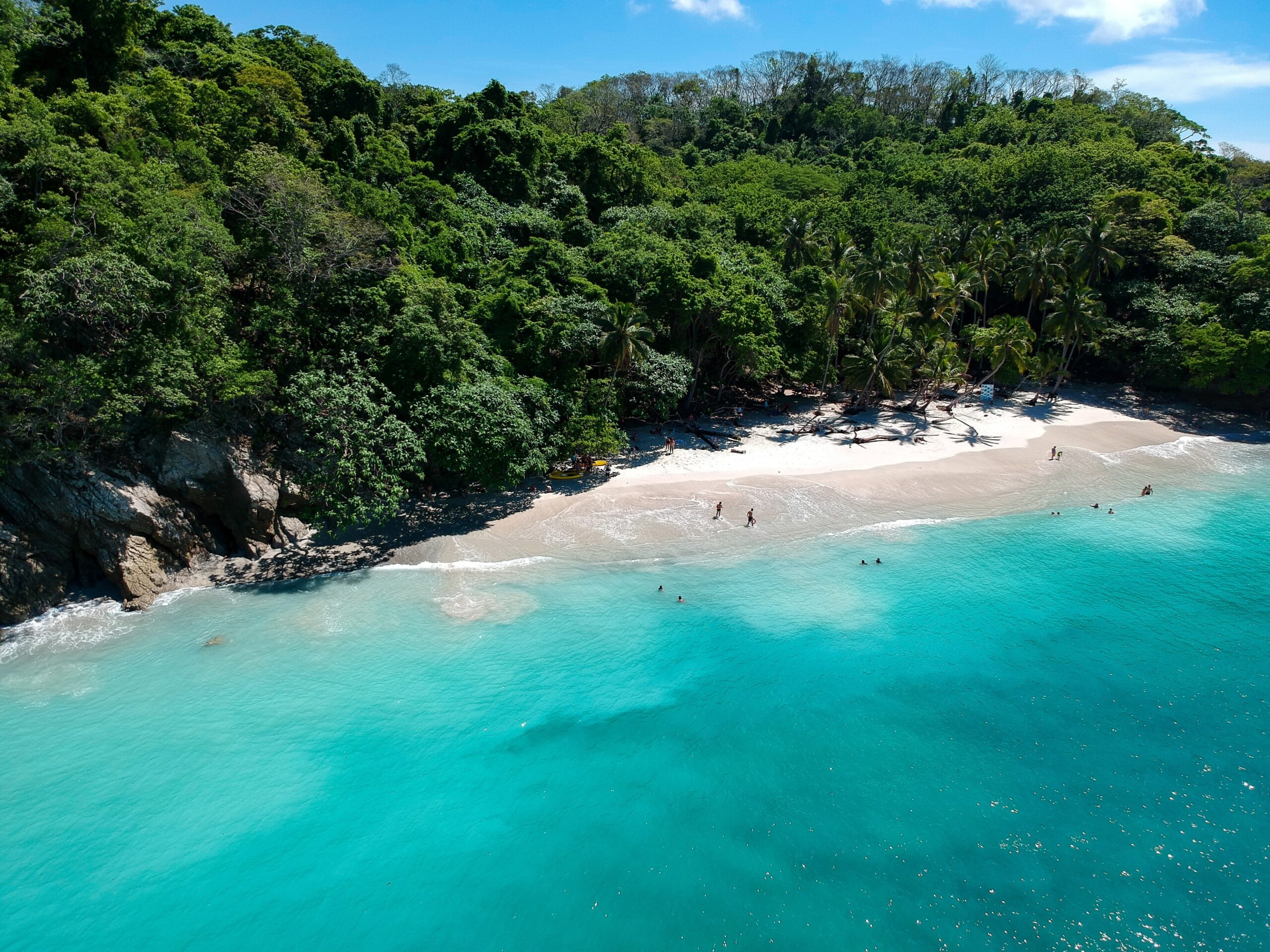
Tortuga island tour
The Islas Tortuga or Turtle Islands are just 3 kilometers from the main beach of Curu Wild Life Refuge. Departure is at 9am from Curu beach, inside Curu Wildlife Refuge, but we recommend to be at least 15 minutes before, to get ready. The trip takes about 10 minutes on boats with outboard motors.
The waters are calm and are protected by the same islands. During the boat tour, it is common to see dolphins, humpback whales, turtles and seabirds. Trees and vegetation adorn the sedimentary rock that forms the coastline between Curu and Islas Tortuga. The principal island is named Tolinga, is about 120 hectares (296 acres) and has two white sand beaches with palm trees and crystalline waters. The Mortero Islands are part of this group and are considered as being the best place for snorkeling in the east coast of the Nicoya Peninsula. On the main beach of the island, we have a special place with tables and benches on top of teak tree trunks, where we offer our guests fresh fruits, sodas and snacks in appreciation for your visit. As part of our compromise with nature, we visit a beach that is part of the main island but has fewer visitors, sometimes is only our group at the beach. Return to Curu is scheduled at 12:15, but you can ask our staff for the option of staying longer. This tour has been designed so you can enjoy the beach in the morning when there are fewer visitors in the islands, and enjoy nature at Curu in the afternoon. We return to Curu by a different route which will provide us with the memorable experience of crossing under Rainbow Rock or Arco Iris. We recommend comfortable clothing for the beach in addition to sunscreen, glasses, hat and other types of protection from the hot sun. When you snorkel, it is necessary to protect your back as it is the area most exposed to the sun. Boats depart every day around 9 am from Curu beach, and we recommend you be there 15 minutes before so you have time to select the snorkeling gear that best fits you. The boat will take you in a 10 minutes ride to the islands. Snorkeling is from the boat and you will have about 1hr to explore the area around Morteros Islands. The boat will stop at Tortuga beach for 2 hrs, so you will return to Curu around 12:30 to continue with other activities if desired. If you need to schedule a different time for departure or for getting back please let us know, there´s no extra charge.

Scuba diving
In 2003 we started operating the diving activity as a complement to our main activity of snorkeling. The diving sites are around the Islas Tortuga in the south of the Nicoya Peninsula. Today we are the largest company operating in the central Pacific coast of Costa Rica working under PADI standards.
Our base is inside the Curu Wildlife Refuge, and our guides are local divers with a lot of knowledge of the area. During all these years we have acquired the knowledge of currents, tides, marine life and all the factors that are important when diving. The dive sites have been selected from several that we explore and study every year. You can choose one or two dives, depending on your time, budget and experience, each dive is at a different site around Tortuga Islands. We can take you to sites where white tip sharks are common all year round. In the dry season (December – April) the big manta rays visit us, but all year round you can easily see eels, spotted eagle rays, puffer fish and many others. If you are inexperienced no problem, because for safety reasons we consider every diver as a beginner, so we will take care of you all the time, that is why one of our Dive Masters will guide you underwater. Our groups are small so we ensure that divers enjoy themselves more and do so in a safe way and without pressure from other more experienced divers, this way we also achieve our goal, to have a unique experience. For the interval, we visit the main beach of Tortuga Islands, where we will prepare some fresh fruits and soft drinks, and enjoy this paradise for approximately 1 hour. Back at the base inside the Curu Wildlife Refuge, you will enjoy the grace and beauty of the wildlife highlighting the white-faced monkeys and white-tailed deer. Inside the park, you will find facilities such as showers, toilets, souvenir shops and nature trails.
Practical Information
Temperature
In the dry season (December-April) the average water temperature is approximately 27 ºC or 81 ºF, sometimes the thermoclines can lower the temperature a few degrees to 15 meters or 45 feet. The ambient temperature during the dry season can rise to 35ºC to 40ºC or 90ºC to 110ºF.
In the rainy season (May to November) the water temperature can drop to 25ºC or 77ºF, and the ambient temperature can be in the range of 25ºC or 30ºC or 77ºF to 85ºF.
Visibility
In the dry season (December-April) visibility can be between 10 to 30 meters or 30 to 90 feet. In the rainy season visibility can be reduced by half. Among the different factors that can affect visibility are:
-Strong waves due to storms in the Pacific Ocean.
-Intense rains for prolonged periods, which cause the river flow to drag sediment to the dive site.
-Excess of plankton in the water due to fertilizers that are carried by rivers to the ocean.
-Strong winds that create a surface wave, which can raise sediment in shallow places.
Immersion
The immersion time (bottom time) will depend on the diver’s air consumption, but on average it is about 45 minutes. The aluminum bottles or tanks we use are 12 liters or 80 cubic feet. The average depth is about 15 meters or 45 feet. The diving sites are covered by large rocks and the seabed can be covered with white sand and small stones. The movement of the waves is always present, even in deep places, so this can be confused with sea currents, but this is avoided by our expert Dive Master choosing the most suitable sites for that particular day.
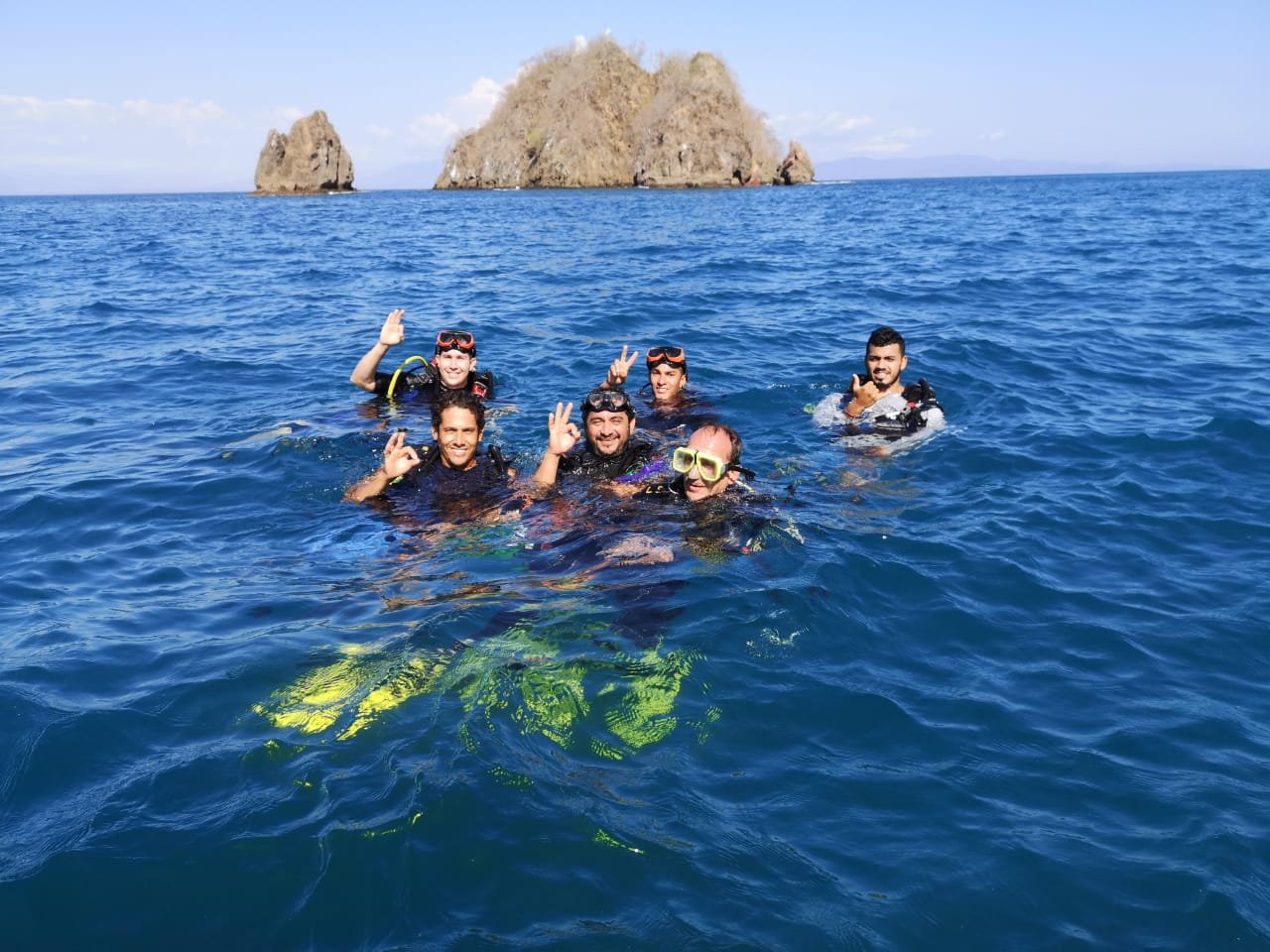
Snorkeling
From the main beach inside Curu Wild Life Refuge, our company will transport you by boat to Islas Tortuga, famous in Costa Rica for snorkeling and its beauty. The trip takes about 10 minutes by a sea that is normally smooth and safe. Departure is scheduled at 9 am, you can contact us for more options.
On the way to the islands, you will be able to enjoy the beautiful coastline along with some marine life. The exciting experience of passing with the boat through the hole in the rock called Arco Iris (Rainbow Rock) is one of the best parts of the tour. Our staff will take you on the boat tour showing you the wildlife and explaining the reason for the name of the islands and some of their history.
For snorkeling, we will take you with the boat to the group of islands called Morteros. If you don’t snorkel, we can drop you off at the main beach so you can relax and feel like you are in paradise. This snorkeling site is famous for a lot of colorful fish and some corals. On the Pacific coast of Costa Rica there is not much hard coral, but many fish and shellfish that catch your attention. Among the most common species, you will find the king angelfish, Cortez angelfish, damselfish, starfish, eels, gobies and many others.
After about 1 hour of snorkeling, our captain will take you to the main island. We visit a beach that is located next to the main one, so there will be fewer visitors on this beach that is part of the main island, where our staff will prepare some fresh fruits, soft drinks and snacks, in addition, you can sunbathe or swim. We will make a stop at this beach for approximately 2 hours, however, you can ask the staff for the option of staying longer on the islands, he will inform you about the option of taking another one of our boats back, depending on the schedule that day.
No reservation is required for the tour, just be at our office inside the Curu Wildlife Refuge. 15 minutes before the departure time you can buy the ticket for the boat and you will be able to live this adventure. Only if you require lunch, we will ask you to call or write one day in advance to make a down payment for the formal reservation.
On the Tortuga Islands tour, if you want to add lunch, then we need you to contact us to make a reservation. The cost of lunch is $10 and you can choose between fish, chicken or vegetarian. It is prepared with fresh local fish from the Sustainable Fishing Area that we support, all served by our staff on the island or you can ask to have lunch ready at the Curu Wildlife Refuge after the snorkeling tour.
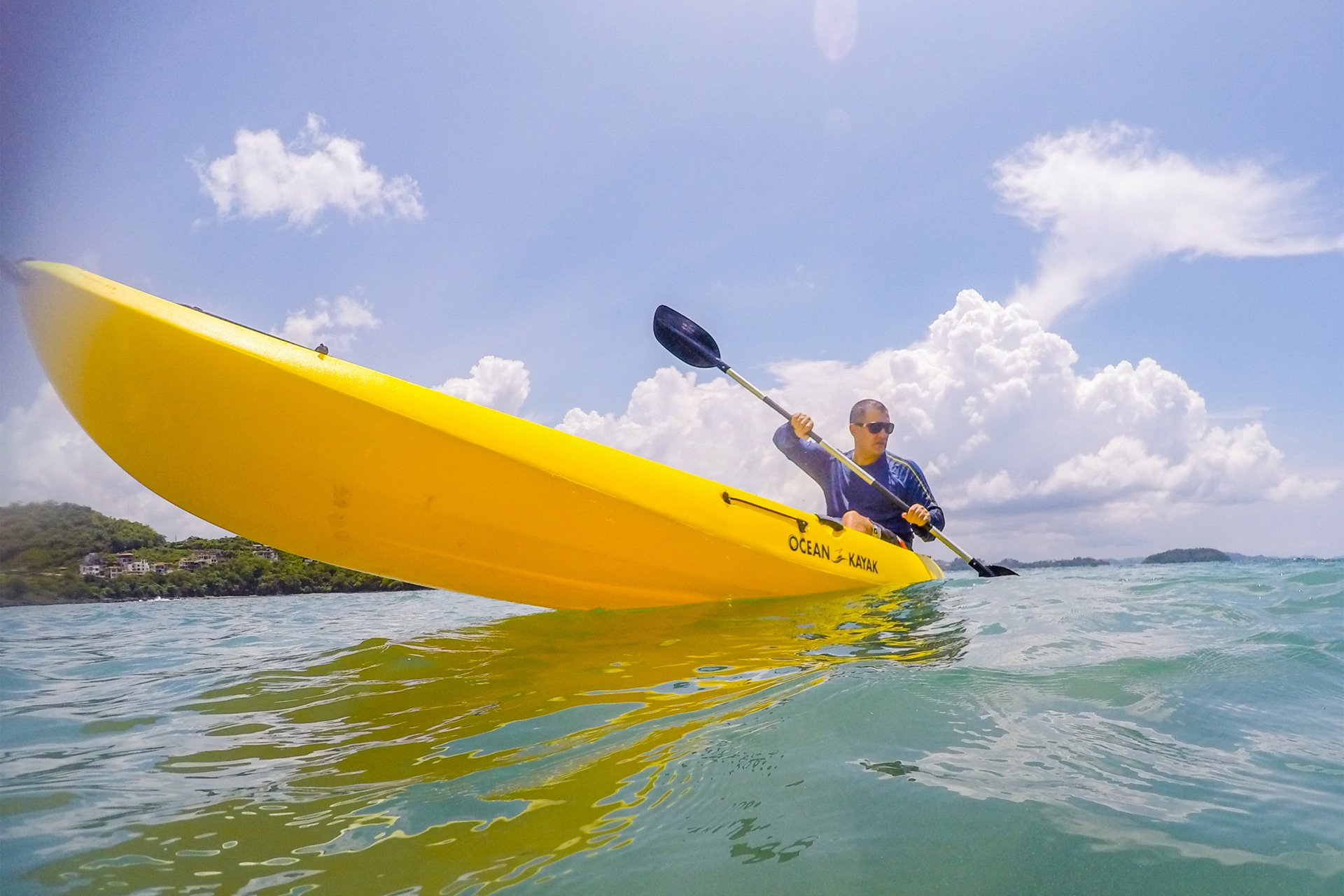
Kayaking
For bioluminescence kayak trips, visit the section Packages or Kayak Packages. For guided kayak tours visit the section Packages. For multi-day kayak trips visit Kayak Packages. We have kayaks sit-on-top or sit-inside so that both beginners and experts can have an unique experience.
Live a unique experience paddling in the calm waters of the Curu bay or estuary (river) in the same place. You can also paddle to Tortuga Island. Another option we offer is to visit the caves or beaches of Curu, and Quesera or Posa Colorada beach, both with white sand. We offer a bioluminescence trip to Quesera beach, starting at 5 pm and returning at 8 pm. We rent kayaks by the hour so you can navigate at your own pace and where it suits you best.

Bioluminiscence
This bioluminescence tour is more than just an hour trip sea kayaking at night. It’s a three-hour interactive experience where different scenery is combined. Sun set, beach time and swimming with the bioluminescence. The tour from Curu is by boat.
We offer another option that starts from Paquera, 150 m east of the ferry dock. This other option is by kayak, we paddle around the coast to see the sunset and observe nature. Then we stop at a place to swim with the bioluminescence.
This tour that starts from the Curu Wildlife Refuge can be combined with other tours, such as snorkeling at Tortuga Island starting at 12:30 pm and continuing with the bioluminescence tour, so both tours will end at 7:30 pm. You can have a nature guide before the tour inside Curu. We can quote the tours depending on what you would like to do on the same day.
We leave at 5 pm from the quiet bay of Playa Curu towards Playa Isla Tortuga, a beautiful white sand beach that is part of a sustainable fishing area. The distance to travel is about 5 km and it takes about 20 minutes by boat to the beach.
Once on the paradisiacal beach, you can relax on its fine white sand to watch the beautiful sunset, while enjoying fresh fruits and house drinks.
There is time to swim in the crystal-clear waters just before the staff gives an explanation of the phenomenon of bioluminescence, what causes it and why we can observe it.
As night falls, you can observe the phenomenon of lights in the water, caused by organisms reacting to movement. You can observe this phenomenon from the shore of the beach or dare to swim, so you can enjoy the halo of light around your body as you float in the water.
We also provide snorkeling masks so you can see the beautiful natural neon lights underwater.
The return trip will begin at 7:00 pm to be at Curu beach at 7:30 pm, which offers facilities such as showers and toilets. You can leave Curu after the tour.

Whale watching
The warm waters south of the Nicoya Peninsula have been visited by whales that migrate from the colder waters in the Northern Hemisphere or the Southern Hemisphere. In our marine area, we see Humpback whales that traveled 6000 kilometers to give birth.
Whales give birth to their calves in warmer waters, protected from predators such as white sharks and killer whales.
These whales leave their feeding grounds in South America during the summer and spring seasons, but as the polar winter approaches in the southern hemisphere, they begin their migration to the waters near the coast of Costa Rica. At the end of August, the first individuals arrive in the waters near the Curu and Tortuga islands. The females carry the new calves in their bellies and give birth in the calm, shallow waters where they will learn to swim and behave like whales. The mother whale and her calf will remain in the vicinity for about 2 months, this time is used for training and nursing, then both begin their journey back to the feeding grounds in South America. During these two months spent on the coast near Curu, the females give birth and are almost immediately ready to mate with the males who have migrated with the females, so the males are seen courting (singing) and mating in the same waters where the mothers give birth. We have hydrophones to listen to their mating songs. Once the baby whales are strong and slightly trained, the mothers (who carry the new generations in their bellies) begin their return to feeding sites in the southern hemisphere.
During the months of August to November, these huge mammals can be seen jumping and moving in the waters near Curu and Tortuga islands, so sighting them is easy.
As part of our contribution to these giant mammals, we are funding a whale watching study (research), in which tour companies, scientists and local fishermen participate. This is the first study to be conducted with whales in the Tortuga Islands area. By hiring our company, you guarantee that part of your money is invested to benefit the species.
We are also studying dolphins in the area, so in addition to whales, dolphins can be seen during these tours.

Sport fishing
We own 24 feet boats for coastal fishing in the southern part of the Gulf of Nicoya, in Paquera near the Tortuga islands, where you can find fishes such as the Mahi Mahi, Mackerel, Sailfish, Rooster, Snapper, Grouper. Many of these species are migratory.
In the months of November to February the arrival of the Dorado is expected, renowned for its strength and jumping ability. With the support of Curu Tourism, in 2014 the Responsible Fishing Area was established in Paquera and Tambor, which covers 80 km of coastline that are under a special type of management to ensure sustainability for many more years. Our company supports local small fishermen by offering some local fishing tours, operated by local fishermen. Dolphins or even whales are seen near the responsible fishing sites, ensuring their preservation and protection. Dolphins visit this area to feed on the abundant fish that inhabit the area. Whales come here seasonally to give birth to their young, away from the frozen waters of their feeding sites.
Some birds are regularly seen looking for fish to feed on and feed their young. Among the most common that can be seen are: seagulls and boobies. With the establishment of the Responsible Fishing Area, the protection of birds and their offspring is achieved.
The elegant pelicans are always waiting for an easy snack. They are the faithful companions of fishermen, present at all times of the year, although it is during the dry season that they nest on nearby islands.
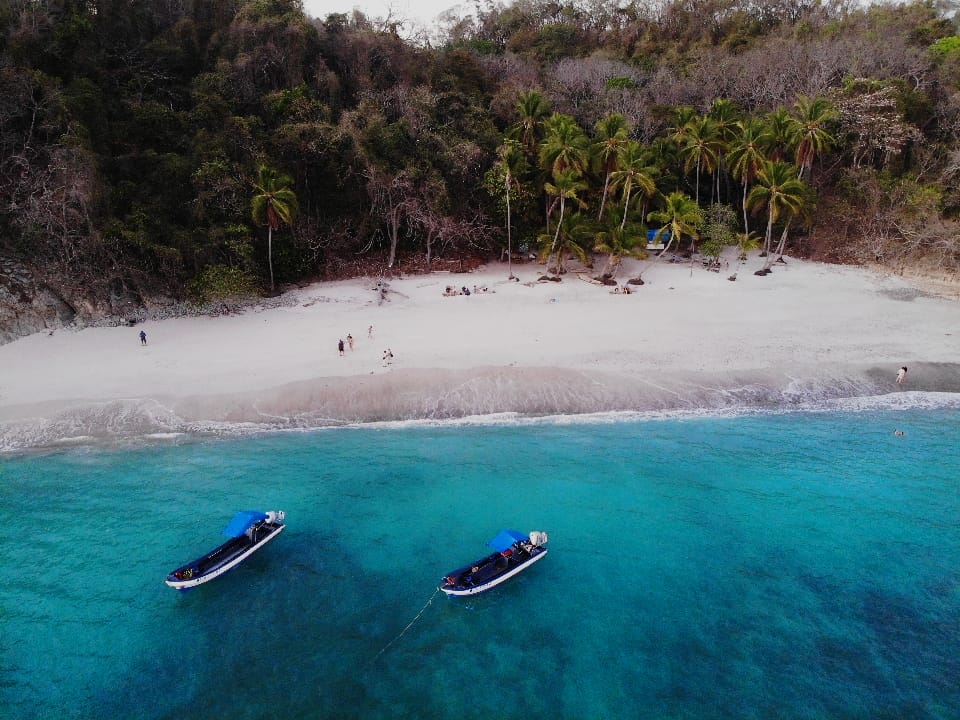
Boat tours
We offer shuttle boats to different sites in the area. In addition to special or private tours designed according to your needs. Some of the boat tours to the island of the Nicoya Peninsula are Organos beach, Quesera beach, Tortuga islands and San Lucas island. Please contact us for more information.
Playa Organos
Playa Organos is located in the northeastern part of Curu, 6 km from the ferry dock near the village of Paquera. The 3 km long grey sand beach has a river or estuary in the middle. This river is navigable during high tide.
It takes about 10 minutes by boat from Curu beach or 40 minutes by kayak.
Playa Quesera
Playa Quesera is part of the Curu Wildlife Refuge. This beach is about 100 m long (300 ft) with fine white sand made up of dead corals and shells.
It takes about 5 minutes to reach the beach by boat or 30 min by kayak.
Tortuga Islands
The Tortuga Islands are considered one of the most beautiful beaches in our country. It is about 15 minutes by boat or 1 hour by kayak. You can snorkel, swim or just relax in the beautiful landscape with white sand and palm trees, suitable for all ages. On the boat tour you will learn about the names of the islands and about the nature and history of the island group.
Isla San Lucas
This place is located about 30 minutes from Curu by boat and is a protected area of about 500 hectares. It used to be one of the places where the worst criminals in the country were sent, to be forgotten by society.
Many died on the island and many others trying to escape from it. A certain José León Sánchez later became famous when he wrote a book called La Isla de los Hombres Solos which was made into a film.
On the island there are paintings made by prisoners, as well as modules or punishment cells.
Approach
About Curu wildlife refuge
Curu Wildlife Refuge was founded by Federico Schutt, a visionary who came to the area in 1933 to develop this beatiful piece of land with the idea of managing natural resources in a rational and controlled way, so it could become a self-sustainable area. Today, his sons continue the work, including Luis Schutt, one of the founders of Turismo Curu.
Curu currently has an area of 1500 hectares of which 85% is protected forest and wild life. The rest is use for cattle and agriculture in combination with wild life management.
Within the area you can see different types of habitats such as:
– Dry forest
– Evergreen forest
– Wetlands
– Plantations
– Other large number of options for animals to feed and reproduce
Contact us for details and bookings
Testimonials
WHAT THEY SAY
Over the years we have received many visitors that enjoyed the natural beauty of Curu Wildlife Refuge and the zones around, these are some of their comments.
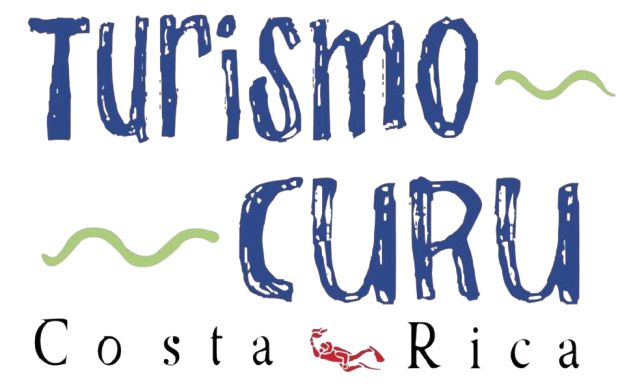
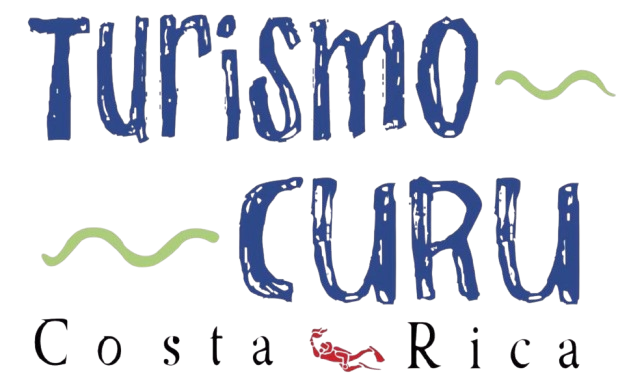

Jeanne MDate of experience: June 2024